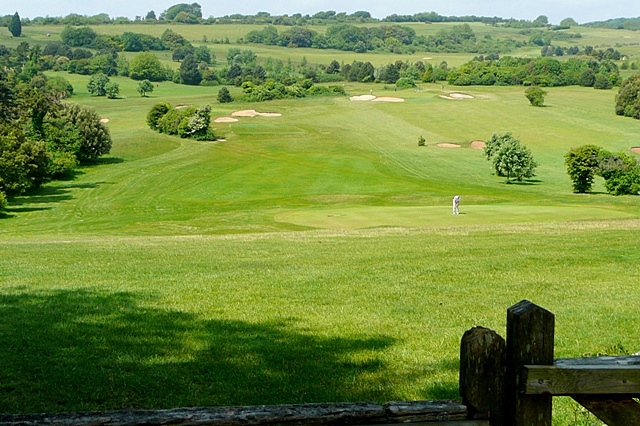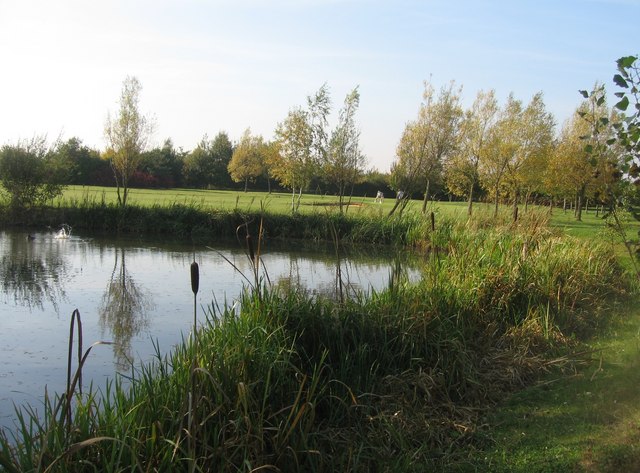Before I get too far in to writing this article I have a confession to make. I am not a golfer. I have never played golf. The closest I have come to doing so was at the age of six when I discovered a set of ancient clubs in the cellar of my childhood house when our family moved there in the early 1990s. The trouble was that they were nearly as big as I was at the time.
Golf bizarrely returned to my life during my years as an undergraduate at Bristol University. I chose to write my final year history dissertation on earthworms (available here if you happen to be interested…), looking specifically at how human beings have interacted with and written about them since Darwin’s treatise, which was published in 1881. Inevitably, my work took me to the Soil Association library, trawling through agricultural and horticultural documents. However, it was by chance that I came across a number of golfing handbooks, which outlined a fascinating story: that of golf greenkeepers’ war on earthworms. If you look out on a lawn with a healthy population of earthworms you should see hundreds and maybe thousands of little earthworm casts, excreted organic material that has passed through the alimentary canal of an earthworm. For a gardener these castings are like gold as they are rich in water soluble nutrients that are immediately available to plants. However, for a golf greenkeeper of the early to mid-twentieth century they were a nuisance as they ‘ruined’ their previously perfect green, only created through hours upon hours of hard and meticulous work. For greenkeepers the earthworms had to go, and this often meant using toxic chemicals such as mercuric chloride (HG2Cl2) or sodium cyanide (NaCN).
‘I was almost at my wits’ end, but was by no means beat in the battle, so looked about for another weapon to circumvent my enemy. At last I hit on something that was really of some good. I got on the right side of one of the members, who was a wholesale druggist and I persuaded him to give me a quantity of corrosive sublimate.’
The above is a quote from Peter Lees, a greenkeeper from Edinburgh, who published a handbook for greenkeepers in 1918 called Care of the Green.
Greenkeepers of the early twentieth century also used rotenone (derris dust) and mowrah meal as well as formaldehyde and these substances worked their way into water courses and poisoned fish.
This is my context for golf. Limited but seen through the eyes of a six year old child, a historian (and a writer on conservation issues). As a sport I see those who play it as incredibly skilful but personally I won’t be taking it up anytime soon.
How much land is taken up by golf courses today?

There are around 2000 golf courses in Britain although there are contrasting figures stating how many hectares of land they are spread over. Figures for England vary between 5721ha (the UK National Ecosystem Assessment) and 270,000 ha (housing consultant Colin Wiles). The Scottish Golf Union does not have a county by county breakdown of golf courses so it is difficult to tell the area that they take up. However, in St Andrews there are 12 courses.
The county in England with the densest golfing territory is Surrey which has 103 clubs at an average size of 45ha (some basic maths makes this 4635ha).
So, when it comes to the environment, is it a good or a bad thing? Obviously greenkeeping has come on enormously since the days of Peter Lees and today there is far more concern (and regulation) for the environment.
The majority area of a golf course is of course, by its nature, a vast expanse of shortly trimmed lawn. It lacks in wildlife potential and is quite rightly looked upon by most conservationists as a desert. However, there are other areas of land on golf courses that are actually positively managed for conservation. As Britain becomes increasingly built upon could we see golf courses as an opportunity for conservation? If managed appropriately could they provide a much needed green lung for species?
Almost all golf courses will have expanses of rough grassland which are not intensively managed as the greens and fairways and may even be out of bounds to players. These are valuable areas.
Depending on their specific nature these areas can be managed to protect wetland, heathland or perhaps even wildflower meadow or woodland habitats. This guest blog article on the Bumblebee Conservation Trust website from a few years ago shows what can be done on gold courses to improve prospects for wildlife.
What could be done on golf courses to improve conservation efforts?
Rough Grasslands

Introducing areas of rough grassland on courses can benefit wildlife. The specific grassland species will vary depending on the environmental conditions of the course (nutrient availability, moisture availability and pH).
Heathlands

Heathlands rely on human intervention to survive. It was originally created by the clearance of forests and conversion to agricultural land. By removing trees the soil is exposed, nutrients leach and soil can become more acid. This makes way for gorse, heather, bilberry, broom and purple moor grass. If left unmanaged then pioneer trees such as silver birches will try to take over. Heathlands are good habitat for birds such as Dartford warbler and Woodlark as well as slow worms and smooth snakes. By draining and preventing succession, heathland can come to thrive on golf courses.
Water

Ponds and lakes do well on golf courses and so long as care is taken to prevent nutrients leaching into the water they can provide great benefits for biodiversity. Ponds can obviously be used to store water for times of drought or hold water to ‘slow the flow’ to prevent flooding elsewhere.
Woodlands

Areas of trees can look good on golf courses, so they have an aesthetic and amenity value, and they also help to shield golfers from wind. They can diversify the habitat availability on golf courses and provide space for a whole range of plants and animals.
Conclusions – could more be done?
Lots of golf courses now have conservation plans and work to improve biodiversity on their courses. However, there is always more that could be done. As the green belt is put under increasing pressure and farmers are told they need to boost yields, other areas of land, such as golf courses, will have to play their part in conservation efforts.
If you know of any specific examples of conservation work being undertaken on golf courses I’d love to hear about them. Please post in the comments below.


I believe the Gleneagles golf course in Scotland was working with the Perth & Kinross Trust on conservation plantings.
We (ArbNet) have been interested in pursuing golf courses to become accredited as an arboretum through our ArbNet Arboretum Accreditation Program. We have many non-traditional institutions that become accredited and advance the planting, appreciation, and conservation of trees.
This is a great opportunity for golf courses!
Hi,
On a broader point, not specifically related to golf courses and their conservation value, but I feel views such as those expressed by Ben within this article might be the most sensible attitude to adopt when tackling nature conservation challenges in the future. For instance, my shared blog a few months back speaking of pheasant rear and release sites and their conservation value. Can they benefit the wider natural environment, where managed well, hell yes they can and do, time and time again. Further examples of perceived detrimental environmental zones are our Grouse moors, airfields, large and small farming enterprises, uplands, neglected woodlands, etc. In truth, all these often disconnected fragments of the UK landscape, offer plenty of worth, you just need somebody to record it. WE should all open our eyes and ears to the good that is out there, be proud of what we’ve got and stand up against those who choose to undermine its potential. I agree with Ben, in that there is much room for improvement, but that’s true of life in general. Let’s get connected with the land and piece together those fragmented views of what works and what doesn’t when it comes to UK’s green and pleasant lands.
Hi,
This a great article Ben and one I can relate to very well
I am a Woodland Ranger for Belfairs Woods and Nature Reserve, Essex Wildlife Trust and the site me and my team of volunteers manage in Southend -on-Sea comprises of 200 acres of ancient woodland which has an 18 hole golf course attached to it with several fairways running through the middle of the woodland. The golf course here is vital for wildlife conservation, the rough grassland we manage in between the fairways supports a huge diversity of wildflowers, birds, reptiles, mammals and invertebrates including many species which are in decline. The fairways which run through the woodland are surrounded by towering ancient oak trees which support woodpeckers, tree creeper and nuthatch along with bats such as noctules which fly up and down the fairways repetitively hunting moths and midges in the evenings. The greens and fairways are great feeding areas for green woodpeckers which feed on the many ants that can be found there, thrushes also benefit from these open green spaces feeding on earth worms. The banks of the sand bunkers have the most interesting flora of all supporting many species of legumes such as knotted clover, vetches and trefoils. So far I have identified 24 different species of butterfly on a butterfly transect which I set up on the golf course here 3 years ago, since surveying this area I have identified a large colony of marbled white butterflies which is now believed to be one of the highest density populations in Essex!
All of this plus more would not be here if it wasn’t for the important habitat the golf course has provided. The area is surrounded by heavy development and receives many visitors to the woods, but due to the golf course restricting use to just golfers the site is very much protected, hence the reason for why it holds such a broad diversity of wildlife. I am sure the same can be said for many golf courses in the country. The management of these areas barely alters/ interferes with the existing management programmes for golf courses, all it takes is a little consideration when mowing with timings and amounts of grass to be left in the roughs etc and ensuring these areas are kept clear of competition from pioneering species like Ben mentions such as birch and bramble which will ultimately transfer these rough grassland areas in between fairways into scrub and woodland. Some of this is good but too much can be disastrous to some species. A good variety of habitats its what we should all be aiming for.
Golf courses along with parkland, gardens and other amenity areas are becoming increasingly more important as population increases and I think Bens article is a great way to promote the awareness of this.